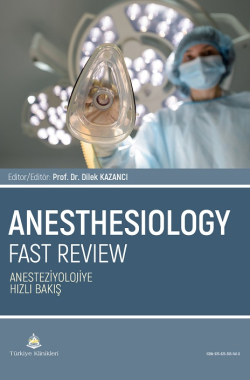IMMUNE SYSTEM PHYSIOLOGY
Ayşe Gizem Saraçoğlu
Ankara Bilkent City Hospital, Department of Anesthesiology and Reanimation, Ankara, Türkiye
Saraçoğlu AG. Immune System Physiology. In: Kazancı D, editor. Anesthesiology Fast Review. 1st ed. Ankara: Türkiye Klinikleri; 2025. p.79-89.
ABSTRACT
- The immune system is a sophisticated defense mechanism that safeguards the body against infections, maintains homeostasis, and facilitates tissue repair.
- It consists of two main components: innate immunity, which provides a rapid but nonspecific response, and adaptive immunity, known for its high specificity and builds long-term memory.
- Innate immunity relies on cells like macrophages, dendritic cells, and neutrophils, along with signaling molecules such as cytokines.
- Adaptive immunity involves T and B lymphocytes, which recognize antigens and generate targeted immune responses.
- One of the primary functions of the immune system is to differentiate between the body’s own cells and foreign invaders, thereby preventing autoimmune diseases.
- It continuously adapts to combat various pathogens, including bacteria, viruses, fungi, and parasites.
- The immune system also contributes to identifying and eliminating cancerous cells, thereby inhibiting tumor development.
- Aging weakens immune defenses through immunosenescence, leading to increased infection risk and reduced vaccine effectiveness.
- Immunosuppressive treatments, used for autoimmune conditions and organ transplants, can lower the body’s capacity to combat infections and cancer.
- A deeper understanding of immune mechanisms helps in developing better therapies for infectious diseases, cancer, and immune disorders.
Keywords: Immune system; Immunity, innate; Adaptive Immunity; Autoimmune Diseases; Immunotherapy
×
Kaynak Göster
Referanslar
- Janeway CA Jr, Travers P, Walport M, et al. Immunobiology: The immune system in health and disea-se. 5th ed. Garland Science; 2001. Available at: [Link]
- Medzhitov R, Janeway C Jr. Innate immunity. N Engl J Med. 2000;343(5):338-344. [Crossref] [PubMed]
- Xiao T. Innate immunity and inflammation. Cell Mol Immunol. 2017;14(1):1-3. [Crossref] [PubMed] [PMC]
- Goldszmid RS, Dzutsev A, Trinchieri G. Host immune response to infection and cancer: unexpected commonalities. Cell Host Microbe. 2014;15(3):295-305. [Crossref] [PubMed] [PMC]
- Abbas AK, Lichtman AH, Pillai S. Cellular and molecular immunology. 9th ed. Elsevier; 2019. Avai-lable at: [Link]
- Murphy K, Travers P, Walport M, et al. Janeway's Immunobiology. 8th ed. Garland Science; 2012. Available at: [Link]
- Yadav DK, Yadav N, Khurana SMP. Chapter 26 - Vaccines: present status and applications. In: Verma AS, Singh A, eds. Animal Biotechnology. 2nd ed. Academic Press; 2020:523-542. [Crossref] [PubMed]
- Akira S, Takeda K, Kaisho T. Pathogen recognition and innate immunity. Cell. 2006;124(4):783-801. [Crossref] [PubMed]
- Walker LSK. The link between circulating follicular helper T cells and autoimmunity. Nat Rev Immu-nol. 2022;22(9):567-575. [Crossref] [PubMed] [PMC]
- Boyman O, Sprent J. The role of interleukin-2 during homeostasis and activation of the immune sys-tem. Nat Rev Immunol. 2012;12(3):180-190. Published 2012 Feb 17. [Crossref] [PubMed]
- Lanzavecchia A. Antigen-specific interaction between T and B cells. Nature. 1985;314(6011):537-539. [Crossref] [PubMed]
- Matzinger P. The danger model: a renewed sense of self. Science. 2002;296(5566):301-305. [Crossref] [PubMed]
- Mellman I. Dendritic cells: master regulators of the immune response. Cancer Immunol Res. 2013;1(3):145-149. [Crossref] [PubMed]
- Shamji MH, Valenta R, Jardetzky T, et al. The role of allergen-specific IgE, IgG and IgA in allergic di-sease. Allergy. 2021;76(12):3627-3641. [Crossref] [PubMed] [PMC]
- Ricklin D, Hajishengallis G, Yang K, et al. Complement: A key system for immune surveillance and homeostasis. Nat Immunol. 2010;11(9):785-797. [Crossref] [PubMed] [PMC]
- Polack FP, Thomas SJ, Kitchin N, et al. Safety and efficacy of the BNT162b2 mRNA Covid-19 vacci-ne. N Engl J Med. 2020;383(27):2603-2615. [Crossref] [PubMed] [PMC]
- Okeke EB, Uzonna JE. The pivotal role of regulatory T cells in the regulation of innate immune cells. Front Immunol. 2019;10:680. Published 2019 Apr 9. [Crossref] [PubMed] [PMC]
- Sakaguchi S, Yamaguchi T, Nomura T, Ono M. Regulatory T cells and immune tolerance. Cell. 2008;133(5):775-787. [Crossref] [PubMed]
- Rosenblum MD, Remedios KA, Abbas AK. Mechanisms of human autoimmunity. J Clin Invest. 2015;125(6):2228-2233. [Crossref] [PubMed] [PMC]
- Medzhitov R. Origin and physiological roles of inflammation. Nature. 2008;454(7203):428-435. [Crossref] [PubMed]
- Hanada T, Yoshimura A. Regulation of cytokine signaling and inflammation. Cytokine Growth Factor Rev. 2002;13(4- 5):413-421. [Crossref] [PubMed]
- Zmora N, et al. The role of the immune system in metabolic health and disease. Cell Metab. 2017;25(3):506-521. [Crossref] [PubMed]
- Mahapatra A, Verma HK, Nag S, Singh S, Khattri A, Bhaskar L. Advances in the molecular etiology of severe combined immunodeficiency and its screening. Turk J Immunol. 2023;11(1):1-16. [Crossref]
- Tuano KS, Seth N, Chinen J. Secondary immunodeficiencies: An overview. Ann Allergy Asthma Im-munol. 2021;127(6):617-626. [Crossref] [PubMed]
- Wawrzyniak S, Rakoca M, Kułakowska A, et al. Multiple sclerosis and autoimmune diseases- a case control study. Neurol Neurochir Pol. 2023;57(4):344-351. [Crossref] [PubMed]
- Platts-Mills TA, Woodfolk JA. Allergens and their role in the allergic immune response. Immunol Rev. 2011;242(1):51-68. [Crossref] [PubMed]
- Gonzalez H, Hagerling C, Werb Z. Roles of the immune system in cancer: from tumor initiation to me-tastatic progression. Genes Dev. 2018;32(19-20):1267-1284. [Crossref] [PubMed] [PMC]
- Topalian SL, Hodi FS, Brahmer JR, et al. Safety, activity, and immune correlates of anti-PD-1 anti-body in cancer. N Engl J Med. 2012;366(26):2443-2454. [Crossref] [PubMed] [PMC]
- Zhu Y. Advances in CRISPR/Cas9. Biomed Res Int. 2022;2022:9978571. Published 2022 Sep 23. [Crossref] [PubMed] [PMC]
- O'Neill LA, Pearce EJ. Immunometabolism governs dendritic cell and macrophage function. J Exp Med. 2016;213(1):15-23. [Crossref] [PubMed] [PMC]
- Afzal O, Altamimi ASA, Nadeem MS, et al. Nanoparticles in drug delivery: From history to therapeu-tic applications. Nanomaterials (Basel). 2022;12(24):4494. Published 2022 Dec 19. [Crossref] [PubMed] [PMC]
- Sadighi Akha AA. Aging and the immune system: An overview. J Immunol Methods. 2018;463:21-26. [Crossref] [PubMed]
- Belkaid Y, Hand TW. Role of the microbiota in immunity and inflammation. Cell. 2014;157(1):121-141. [Crossref] [PubMed] [PMC]
- Shipkova M, Wieland E. Editorial: Immune monitoring in solid organ transplantation. Clin Biochem. 2016;49(4-5):317-319. [Crossref] [PubMed]
- Mor G, Cardenas I. The immune system in pregnancy: A unique complexity. Am J Reprod Immunol. 2010;63(6):425-433. [Crossref] [PubMed] [PMC]

